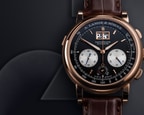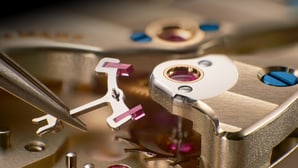A rattrapante chronograph allows comparative, lap-time, and reference value measurements as well as fastest/slowest evaluations. This is possible thanks to two hands seated on concentric arbors. The DOUBLE SPLIT features this arrangement twice: two large seconds hands and two small hands for the minute counters. In the TRIPLE SPLIT there is an hour counter with a third pair of small hands. The following description of the seconds axis applies analogously to the minute- and hour-counter axes.
This is how the double and triple rattrapante mechanism work
The chrono sweep-seconds hand is attached to the outer tubular chronograph centre arbor (1). It is driven by the movement via the chronograph wheel (2). It is rigidly connected to the zero-reset heart cam (3) of the chronograph wheel as well as to the rattrapante heart cam (4).
The heart cam makes it possible to zero a hand as quickly as possible, either clockwise or anticlockwise, whichever is faster. The rattrapante hand must also be resynchronised with the chrono sweep-seconds hand after a lap time has been stopped. The rattrapante hand, which is superposed on the chrono sweep-seconds hand, is attached to the inner rattrapante centre arbor (5). At its bottom end, this arbor holds the disengagement wheel (6) and the rattrapante centre wheel (7) to which the freely rotatable rattrapante heart lever (8) is attached.
Starting and stopping the rattrapante hands
In the basic position, the rattrapante hammer (8) is pressed against the flat side of the rattrapante heart cam (4) by a spring (9), assuring that the rattrapante centre wheel (7) is driven when the rattrapante mode is active. This connects the otherwise separately moving chrono centre arbor (1) and rattrapante centre arbor (5). When the chronograph is started, all three chronograph and rattrapante hands begin to run at the same time.
When the rattrapante pusher is actuated, the interconnected rattrapante switching lever (10) advances the column wheel (11) by one increment. At this point, the rattrapante clamp (12) closes and immobilises the rattrapante centre wheel (7): The rattrapante sweep-seconds hand is now stopped. Concurrently, the minute arresting spring (13) and the hour arresting lever (15) immobilise the rattrapante minute and hour counters. All the while, the three chronograph hands continue to run. When the rattrapante pusher (10) is pressed a second time, the rattrapante clamp (12) opens; the minute arresting spring (13) and the hour arresting lever (15) are pushed aside. The rattrapante hands instantly rejoin the chronograph hands.
Disengagement mechanism
Thanks to a patented disengagement mechanism, the ability to stop lap times does not come at the expense of a loss of amplitude. In conventional designs, as the chronograph hands continue to run while the rattrapante hands are stopped, the hammers (8) that slide on the rattrapante heart cams (4) cause friction, which can have a negative impact on rate stability. In the DOUBLE SPLIT and the TRIPLE SPLIT, this disadvantage is eliminated in that when the rattrapante hands are stopped, two disengagement wheels (6) and (6a) on the rattrapante centre wheel and the rattrapante minute-counter wheel lift the hammers off the rattrapante heart cams that continue to rotate. For this purpose, the disengagement wheels are turned by a few degrees by the disengagement segment (14). The hour counter does not need such a mechanism because the friction loss it causes is negligible due to the high torque and the comparatively slow rotation.
Explore further




Exclusive insights into the world of fine watchmaking
Experience A. Lange & Söhne’s fascinating heritage, unique stories and exquisite timepieces by subscribing to our newsletter.
How can we be of service?
Whether you are in search of a specific model, have questions out of interest or need a service request for your timepiece – we are delighted to help you. We are at your service by phone, email or in one of our boutiques.









